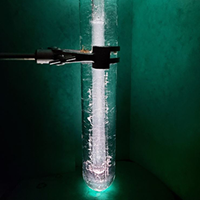2 minute read
NPL is working on determining trace impurities at the level of parts per billion (ppb) in samples of ultra-pure water through inductively coupled plasma mass spectrometry (ICP-MS). It is known that impurities, even at this level, can impact the phase transition temperature of materials.
 The sample was obtained during the manufacture of a triple point of water cell (whose triple point temperature is 273.16 K or 0.01 °C), which is a key fixed point of the International Temperature Scale of 1990, or ITS-90. This topic is very important as impurities are accounted for in the uncertainty budgets (to which an upper limit is attributed in many cases) and could be in the order of tenths of millikelvins. The calibration and measurement capability of the NPL team’s realisation of the triple point of water is currently ± 0.071 mK (k=2) as recorded in the key comparison database of the International Bureau of Weights and Measures, BIPM.
The sample was obtained during the manufacture of a triple point of water cell (whose triple point temperature is 273.16 K or 0.01 °C), which is a key fixed point of the International Temperature Scale of 1990, or ITS-90. This topic is very important as impurities are accounted for in the uncertainty budgets (to which an upper limit is attributed in many cases) and could be in the order of tenths of millikelvins. The calibration and measurement capability of the NPL team’s realisation of the triple point of water is currently ± 0.071 mK (k=2) as recorded in the key comparison database of the International Bureau of Weights and Measures, BIPM.
This project was executed as part of an international key comparison of triple point of water cells, CCT‑K7.2021, which is overseen by the Consultative Committee of Thermometry. Great attention has been paid mostly to the isotopic composition of water so that any deviations from the reference standard composition, Vienna Standard Mean Ocean Water (VSMOW), were corrected. However, residual impurities are not only more difficult to determine accurately at ppb levels, but they can also arise from the manufacturing process of the cell itself (e.g. from the glass envelope).
The results will help understand the relationship between the residual impurities present in the water and their effect on the temperature realised by the cell, by comparing its impurity assay with the performance of the cell in the intercomparison. This work will potentially form part of an international data repository and help guide future investigations in the field.
Dr Rodrigo Da Silva, Higher Research Scientist, commented: “So far very little work has been done to characterise the impurities remaining in the water used in the manufacture of TPW cells, let alone to determine the effect that each one of them would have on the triple point temperature realised by these cells. This work represents a key improvement to the realisation of the temperature scale, and as such is an important part of NPL’s work in providing measurement assurance for stakeholders in the UK and further afield.”
Find out more about temperature and humidity
Find out more about nuclear metrology
18 Oct 2022